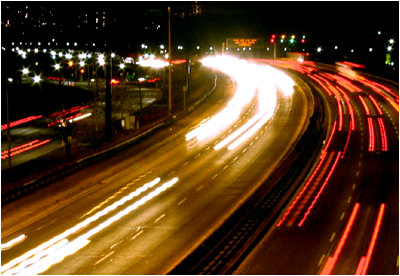

The set of occupancy rates are optimised at the area-wide level. One co-ordinated solution (ALINEA in France, for the Paris ring road and Île-de-France motorways) consists of imposing target downstream occupancy rates on the motorway for each of the local metering systems. More sophisticated systems account for conditions over a long section of the motorway, not just at the individual interchanges. Most of the ramp metering systems that have been deployed are based on demand/capacity or occupancy rate algorithms and are not coordinated on an area-wide basis. Ramp meters may be deployed individually or in combination as a dynamic system. In practice, ramp metering systems are located upstream of recurrent bottleneck congestion points – and have a safety role in addition to relieving main-line congestion.

signs informing users of activation – or impending activation – of the ramp meter.control signals (which can be two-light or three-light) located towards the end of the access ramp before the main carriageway, activated during peak periods.Access can be regulated in isolation (each ramp regulated independently) or centralised, with the flows admitted at consecutive ramps being computed by a comprehensive traffic management system. Timing of on-ramp traffic signals is generally dependent on the prevailing traffic conditions on both the main carriageway and the on-ramp. It is important to have sufficient capacity for queuing vehicles so that the adjacent motorways and access roads are not disrupted by queuing traffic waiting to merge. The signals control the discharge of vehicles from the on-ramp, holding back the merging traffic and breaking up platoons of vehicles as required. Ramp metering is implemented by installing traffic signals on the on-ramps to regulate the flow of traffic joining the motorway during peak or congested periods. monitoring and managing the merging traffic to achieve an even distribution and avoid large platoons of vehicles entering the motorway at once, which increases the risk of flow breakdown.regulating the flow of additional traffic onto the motorway that, if unchecked, would trigger flow breakdown and lead to critical shockwaves.

One goal of metering is to encourage diversion of short-distance trips off the motorway. The aim of ramp metering is to prevent or delay the onset of flow breakdown, to maximise throughput. Once flows become unstable and stop-start conditions set in, there is a significant loss of capacity and queues develop on the motorway due to the volume of traffic. Ramp meters reduce the likelihood of flow breakdown by preventing traffic levels on the main carriageway reaching unstable levels. Merging traffic is held on the ramp to be released at a rate typically controlled by the volume of through traffic on the main carriageway. Detection is needed on the freeway or motorway both upstream and downstream of the merge point. It is used to a lesser extent in Europe and the rest of the world due to the practical problems of comparatively short motorway on-ramps with limited queuing capacity. what effect the work will have on the environmentįind Highways England Road Projects on the map or search by road name, location or the type of project.Ramp metering is a form of tactical management widely used in North America.

Get detailed information about longer term projects like planned maintenance and road improvement schemes. Search the database of current and planned roadworks to find out if your journey will be delayed by roadworks happening on the major road network. Traffic information for major roads in Scotland and Wales is available from: Visit the Traffic England website for live information about traffic and road conditions across the major road network. Get up-to-date information about incidents that are currently causing delays and congestion on major roads managed by Highways England, for example accidents, broken down vehicles and emergency roadworks. Use these online tools to get information about traffic and roadworks on motorways and A roads in England.


 0 kommentar(er)
0 kommentar(er)
